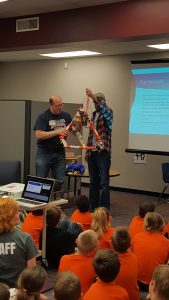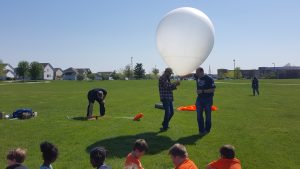It’s a bird, it’s a plane, it’s a … weather balloon
Anyone looking to skies over Johnston on Friday, May 5, around 10:30 a.m. may have noticed a large, white balloon floating through the air.
Like most balloons, it was filled with helium, made of latex, and the movement of it was largely dependent on the wind. But unlike the balloons found in stores, this was a special

Bryan Burkhardt, left, explains what a payload is as part of the weather balloon launch at Horizon Elementary.
balloon, made specifically for the purpose of gathering weather and image data from at least 50,000 feet above the Earth.
Second graders at Horizon Elementary learned all about the data tools used to predict the weather as the culmination to their weather project-based learning unit. Bryan Burkhardt, an instructor at the Des Moines Area Community College, along with his colleagues, spoke to second graders about the purpose of the balloon and the many devices attached to it to collect data.
“It’s like one big science experiment,” said Burkhardt. “We use these balloons to gather important information from places we can’t visit, like way above the earth – higher than most airplanes fly. There are so many cool things we can see and learn from the balloon’s camera.”
Burkhardt showed students the deflated balloon, the parachute attached to the balloon, and the payload – a wooden frame equipped with various instruments and tools used to gather information about air pressure, humidity, temperature, and wind. All in all, the rig weighs about 3.5 pounds. Burkhardt and his crew were estimating the balloon would fly south and in about two hours, reach the Iowa-Missouri border. They use satellite tracking to find the popped balloon and payload.
Students were asked to hypothesize a number of figures related to the balloon, such as how far it would travel south, the air temperature at 50-60,000 feet up, the speed at which it would travel, and the duration of flight.
As the DMACC crew filled the balloon with helium, students shouted out their predictions. Then, with an official countdown, the balloon and payload were released up, up, and away into the atmosphere, headed south.
Watch the official launch:
